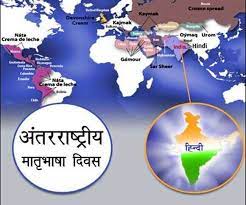23 Feb 2022 International Mother Language Day

International Mother Language Day – Today Current Affairs
- The United Nations Educational, Scientific and Cultural Organization (UNESCO) organizes ‘International Mother Language Day’ every year on 21 February to promote mother tongue based multilingual education.
- Its theme for the year 2022 is: “Using Technology for Multilingual Education: Challenges and Opportunities.” The theme focuses on the potential role of technology in advancing multilingual education and supporting the development of quality teaching and learning capabilities for all.
- There are more than 7,000 languages in the world, while India alone has about 22 officially recognized languages, 1635 mother tongues and 234 identifiable mother tongues.
Today Current Affairs
International Mother Language Day
- It was announced by UNESCO on November 17, 1999 and since the year 2000 this day is being organized all over the world.
- The day also marks the long struggle made by Bangladesh to protect its mother tongue, Bangla.
- The idea of celebrating 21 February as International Mother Language Day was suggested by Rafikul Islam, a Bangladeshi living in Canada.
- He proposed the above date to remember the murders in Dhaka in the year 1952 during the Bengali language movement.
- The objective of this initiative is to protect the diverse cultural and intellectual heritage of different regions of the world and to preserve and promote mother tongues.
- According to the United Nations (UN), every two weeks a language disappears and human civilization is losing its entire cultural and intellectual heritage.
- The competition to learn foreign languages for better employment opportunities due to globalization is one of the main reasons for the disappearance of mother tongues.
Global efforts to conserve languages: The Hindu Analysis
- The period from 2022 to 2032 has been designated by the United Nations as the International Decade of Indigenous Languages.
- Earlier the United Nations General Assembly declared the year 2019 as the International Year of Indigenous Languages (IYIL).
- The Yuelu Proclamation by UNESCO in Changsha (China) in 2018 plays a central role in guiding the efforts of countries and regions around the world to protect linguistic resources and diversity.
India’s initiative to protect mother tongues: The Hindu Analysis
- The recently announced National Education Policy, 2020 is a major initiative to promote education in regional languages.
- Commission for Scientific and Technical Terminology (CSTT) is providing publication grant to promote publication of university level books in regional languages.
- It was established in the year 1961 to develop technical terminology in all Indian languages.
- The National Translation Mission (NTM) is being implemented through the Central Institute of Indian Languages (CIIL), Mysore, under which the VIII of the text books of various subjects in the universities and colleges are being implemented. Translation is being done in all the languages included in the schedule.
- ‘Scheme for the Protection and Conservation of Endangered Languages’ for the protection of endangered languages.
- The University Grants Commission (UGC) seeks to promote regional languages in higher education courses in the country and provides financial assistance to a total of nine central universities under the scheme for setting up centers for endangered languages in central universities.
- Other initiatives of the Government of India include the Bharatvani Project and the proposal to set up an Indian Language University (BBV).
- Recently Namath Basai Program, an initiative of Kerala State Government to educate children of tribal areas in local languages has proved to be very beneficial.
- Google’s project uses Navlekha technology to protect mother tongue. The objective of this project is to increase the availability of online content in Indian vernacular languages.
Related constitutional and legal provisions: The Hindu Analysis
- Article 29 of the Constitution (Article 29 – Protection of the interests of minorities) gives the right to all citizens to protect their language and prevents discrimination on the basis of language.
- According to Article 120 (Article 120 – Language to be used in Parliament), Hindi or English can be used for the proceedings of Parliament, but Members of Parliament have the right to express their views in their mother tongue.
- Part XVII of the Indian Constitution (Articles 343 to 351) deals with official languages.
- According to Article 350A (Article 350A – Facilitation of education in the mother tongue at the primary stage), it shall be the endeavor of every state and every local authority in the country to provide education in the mother tongue to the children belonging to linguistic minority groups at the primary stage of education. Provide adequate facilities.
- Article 350B (Special Officer for Linguistic Minorities): There is a provision for the President to appoint a special officer for linguistic minorities to investigate and report on all matters relating to constitutional safeguards for linguistic minorities.
- Provision for the President to place all such reports before the Parliament and send them to the concerned State Government.
- The Eighth Schedule includes 22 languages namely Assamese, Bengali, Gujarati, Hindi, Kannada, Kashmiri, Konkani, Malayalam, Manipuri, Marathi, Nepali, Oriya, Punjabi, Sanskrit, Sindhi, Tamil, Telugu, Urdu, Bodo, Santhali, Maithili and Includes Dogri.
- According to the Right to Education Act, 2009, the medium of instruction should, as far as practicable, be the mother tongue of the child.


No Comments